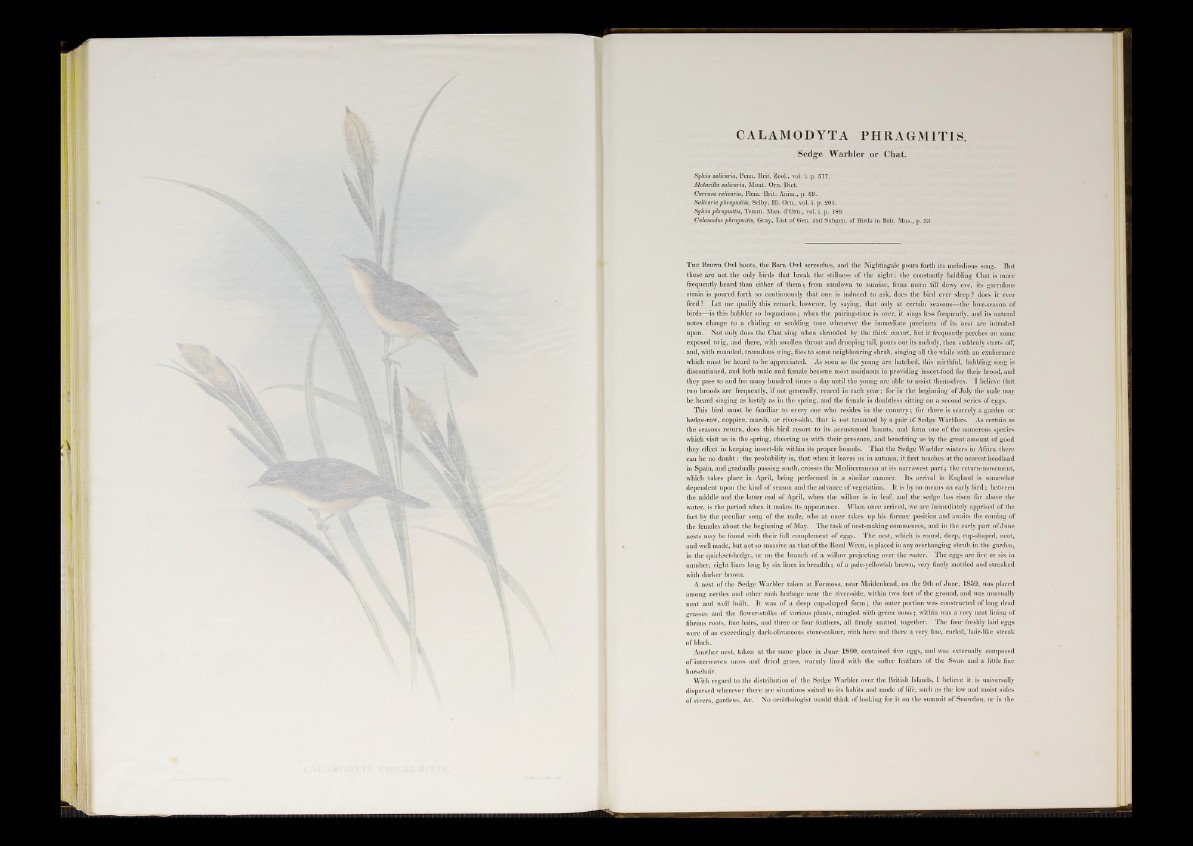
Sedge Warbler or Chat.
Sylvia salicaria, Penn. Brit. Zool., vol. i. p. 517.
Motacilla salicaria, Mont. Orn. Diet.
Curruca salicaria, Flem. Brit. Anim., p. 69.
Salicaria phragmitis, Selby, 111. Orn., vol. i. p. 201.
Sylvia phragmitis, Temm. Man. d’Om., vol. i. p. 189.
Calamodus phragmitis, Gray, List of Gen. and Subgen. of Birds in Brit. Mus., p. 33.
T h e Brown Owl hoots, the Barn Owl screeches, and the Nightingale pours forth its melodious song. But
these are not the only birds that break the stillness of the night: the constantly babbling Chat is more
frequently heard than either of them; from sundown to sunrise, from morn till dewy eve, its garrulous
strain is poured forth so continuously that one is induced to ask, does the bird ever sleep ? does it ever
feed ? Let me qualify this remark, however, by saying, that only at certain seasons—the love-season of
birds;—is this babbler so loquacious; when the pairing-time is over, it sings less frequently, and its natural
notes change to a chiding or scolding tone whenever the immediate precincts of its nest are intruded
upon. Not only does the Chat sing when shrouded by the thick covert, but it frequently perches on some
exposed twig, and there, with swollen throat and drooping tail, pours out its melody, then suddenly starts off,
and, with rounded, tremulous wing, flies to some neighbouring shrub, singing all the while with an exuberance
which must be heard to be appreciated. As soon as the young are hatched, this mirtliful, babbling song is
discontinued, and both male and female become most assiduous in providing insect-food for their brood, and
they pass to and fro many hundred times a day until the young are able to assist themselves. I believe that
two broods are frequently, if not generally, reared in each year; for in the beginning of July the* male may
be heard singing as lustily as in the spring, and the female is doubtless sitting on a second series of eggs.
This bird must be familiar to every one who resides in the country; for there is scarcely a garden or
hedge-row, coppice, marsh, or river-side, that is not tenanted by a pair of Sedge Warblers. As certain as
the seasons return, does this bird resort to its accustomed haunts, and form one of the numerous species
which visit us in the spring, cheering us with their presence, and benefiting us by the great amount of good
they effect in keeping insect-life within its proper bounds. That the Sedge Warbler winters in Africa there
can be no doubt: the probability is, that when it leaves us in autumn, it. first touches at the nearest headland
in Spain, and gradually passing south, crosses the Mediterranean at its narrowest p a rt; the return-movement,
which takes place in April, being performed in a similar manner. Its arrival in England is somewhat
dependent upon the kind of season and the advance of vegetation. It is by no means an early b ird; between
the middle aud the latter end of April, when the willow is in leaf, and the sedge has risen far above the
water, is the period when it makes its appearance. Wlieu once arrived, we are immediately apprised of the
fact by the peculiar song of the male, who at once takes up his former position and awaits the coming of
the females about the beginning of May. The task of nest-making commences, and in the early part of June
nests may be found with their full complement of eggs. The nest, which is round, deep, cup-shaped, neat,
and well made, but not so massive as that of the Reed Wren, is placed in any overhanging shrub in the garden,
in the quickset-hedge, or on the branch of a willow projecting over the water. The eggs are five or six in
number, eight lines long by six lines in breadth; of a pale-yellowish brown, very finely mottled and streaked
with darker brown.
A nest of the Sedge Warbler taken at Formosa, near Maidenhead, on the 9th of June, 1859, was placed
among nettles and other rank herbage near the river-side, within two feet of the ground, and was unusually
neat and well built. It was of a deep cup-shaped form; the outer portion was constructed of long dead
grasses and the flower-stalks of various plants, mingled with green moss; within was a very neat lining of
fibrous roots, fine hairs, and three or four feathers, all firmly matted together. The four freshly laid eggs
were of an exceedingly dark-olivaceous stone-colour, with here and there a very fine, curled, hair-like streak
of black.
Another
r nest, taken at the same place in June 1860, contained five eggs, and was externally composed
of interwo
»ven moss and dried grass, warmly lined with the softer feathers of the Swan and a little fine
horsehair.
With regard to the distribution of the Sedge Warbler over the British Islands, I believe it is universally
dispersed wherever there are situations suited to its habits and mode of life, such as the low and moist sides
of rivers, gardens, &c. No ornithologist would think of looking for it on the summit of Snowdon, or in the